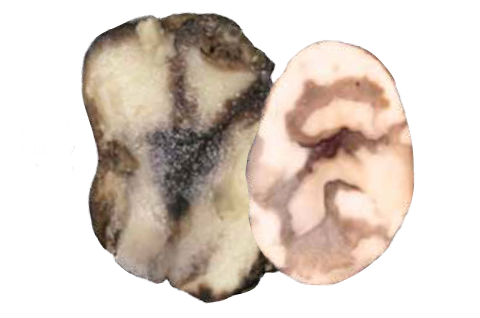
New disease crosses the Atlantic
Soon after their spuds were planted in 2014, some growers in the northeastern United States knew they had a problem.
Much of the crop didn’t even emerge. Growers were looking at stands of only 40 percent, said Steve Johnson, an Extension crops specialist with the University of Maine.
Soon, wilting and blackleg-like symptoms began to appear in affected fields. But this didn’t act like regular blackleg. The mystery pathogen was more aggressive.
“It looked like blackleg on steroids,” Johnson said.
It turned out to be dickeya dianthicola, a seedborne pathogen that’s new to the North American potato industry but has bedeviled European growers for decades.
During the past two years the disease has been detected in several states, mostly in the Northeast. D. dianthicola has caused significant losses to some commercial spud growers in the region, Johnson said. In some cases, farmers have left entire fields unharvested.
Many of the dickeya-infected fields in the Northeast have been linked to Maine seed. A University of Maine lab tested more than 500 tissue samples collected from seed fields in the state during the 2015 growing season.
“Well over 100 tested positive,” for dickeya, Johnson said.
No seed certification tolerances have been established for dickeya in the United States, and it will take a lot more testing and research to do so. Researchers want to determine if there is some level of infection in seed fields that would be acceptable — or unlikely to cause problems in plantings the next year.
“There are no numbers to say that 1 percent is OK, but 2 percent is not. There are no numbers that exist anywhere on that,” Johnson said.
“The only thing that I can defend is a zero tolerance, and that’s not a popular stand,” he said.
Johnson said many of the affected growers are looking to other areas for their seed and some large operations have started requesting field test results for dickeya before buying.
“The market is very quickly sorting this out,” he said. “I think that will continue at an accelerated rate that is far faster than the research.”
Idaho had its first confirmed case of D. dianthicola in potatoes in 2015.
“It’s probably present in several of the potato-growing states,” said Nora Olsen, a University of Idaho Extension potato specialist who found the first positive sample in the state.
“We’re just starting the process of understanding how this disease is going to respond in the U.S.,” she said. “We’re trying to understand how widespread is it, what the risks are and what kind of management practices we need to put into place.”
D. dianthicola is one of six different dickeya species that collectively were formerly known as Erwinia chrysanthemi.
D. dianthicola has been the main dickeya species affecting potato crops in Europe for more than 40 years. However, a relatively new dickeya species called D. solani has emerged within the past 15 years.
Of the two, Dickeya solani is more aggressive and has caused significant losses to potato crops in Europe in recent years, according to research published by the British Society of Plant Pathology.
D. solani has not yet (as of early this year) been detected in North America.
“Because D. solani is a broad host range pathogen, it is highly likely that it will emerge in North America,” said Amy Charkowski, a professor of plant pathology at Colorado State University.
“For example, it could travel here on ornamental bulbs or vegetable seeds and eventually enter our potato system. I expect to see this pathogen emerge in North America over the next decade.”
Dickeya is closely related to pectobacterium, which causes soft rot, stem rot and blackleg in potato. It grows in the xylem of potato plants and can spread throughout the entire plant, including the tubers, Charkowski said.
“Dickeya can cause plants to wilt and die and it can cause potato tubers to rot. It also causes seed piece decay,” she said.
Management methods for dickeya are the same as for pectobacterium, and will also help reduce losses due to many other diseases, Charkowski said.
“Seed potato lots can be tested for dickeya. Seed potato lots with a high blackleg incidence should not be re- planted,” she said.
Dickeya is transmitted through seed cutting, so planting uncut seed will help manage losses, Charkowski said. If seed is cut, the equipment should be sanitized between seed lots and the seed should be thoroughly suberized prior to planting.
“If a high incidence of blackleg or wilt is seen during the growing season, farmers should test for dickeya, particularly in seed fields,” she said.
Dickeya bacterium is enhanced by water and will be worse in low-lying areas of a field.
“If disease is present in low-lying parts of a field, growers should not harvest these potatoes,” Charkowski cautioned.
Copper sprays can be used to reduce spread of the disease, but regularly spraying copper will damage soils, so growers should avoid this if possible, she said.
“Seed potato farmers should sanitize their harvest equipment between seed lots to minimize the potential of pathogen spread between seed lots,” Charkowski said.
Because the pathogen is inside the xylem (inside the tubers), it isn’t possible to eliminate dickeya from harvested tubers.
“Growers can treat potatoes going into storage with products designed to protect wounds from pathogens, and that should help reduce spread during harvest,” she said.
Dickeya can survive inside tubers in storage, but it’s unlikely to cause significant decay problems in storage because it does not grow well at low temperatures, Charkowski said.







